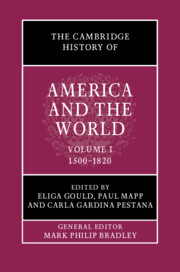Book contents
- The Cambridge History of America and the World
- The Cambridge History of America and the World
- The Cambridge History of America and the World
- Copyright page
- Contents
- Figures
- Maps
- Contributors to Volume I
- General Introduction: What is America and the World?
- Introduction: What Does America and the World “Mean” before 1825?
- Part I Geographies
- Part II People
- Part III Empires
- 9 The Early Iberian American World
- 10 Making Colonies and Empires in North America and the Greater Caribbean
- 11 Imperial Wars, Imperial Reforms
- 12 Law and Empire, 1500–1812
- Part IV Circulation/Connections
- Part V Institutions
- Part VI Revolutions
- Index
9 - The Early Iberian American World
from Part III - Empires
Published online by Cambridge University Press: 12 November 2021
- The Cambridge History of America and the World
- The Cambridge History of America and the World
- The Cambridge History of America and the World
- Copyright page
- Contents
- Figures
- Maps
- Contributors to Volume I
- General Introduction: What is America and the World?
- Introduction: What Does America and the World “Mean” before 1825?
- Part I Geographies
- Part II People
- Part III Empires
- 9 The Early Iberian American World
- 10 Making Colonies and Empires in North America and the Greater Caribbean
- 11 Imperial Wars, Imperial Reforms
- 12 Law and Empire, 1500–1812
- Part IV Circulation/Connections
- Part V Institutions
- Part VI Revolutions
- Index
Summary
In the sixteenth century, Iberian kingdoms claimed extensive territories in North and South America and the Caribbean Sea. The Portuguese sailed from Lisbon to the Azores to Brazil while developing trade routes to Africa, India, Southeast Asia, and Japan. Castilians shipped silver mined in New Spain and Peru across the Atlantic and Pacific Oceans to Seville and Manila. In this transformative period, the nascent nation states of Spain and Portugal integrated the human and natural resources of the Americas into a global network of labor and exchange. Iberia represented the cutting edge of Europe’s overseas expansion. The surge in military-mercantilist activity was driven more by merchants, companies, investors, and free agents than by royal initiative. Iberians also led Europe in adapting laws and theories of governance designed to incorporate new subjects and to maintain control of distant lands. In the sixteenth century, Iberian institutions sponsored innovative projects to collect knowledge on the “new world” and its peoples. In many ways, then, Iberia had set the stage for Europe and America’s engagement with the wider world by 1600.
- Type
- Chapter
- Information
- The Cambridge History of America and the World , pp. 205 - 227Publisher: Cambridge University PressPrint publication year: 2022



